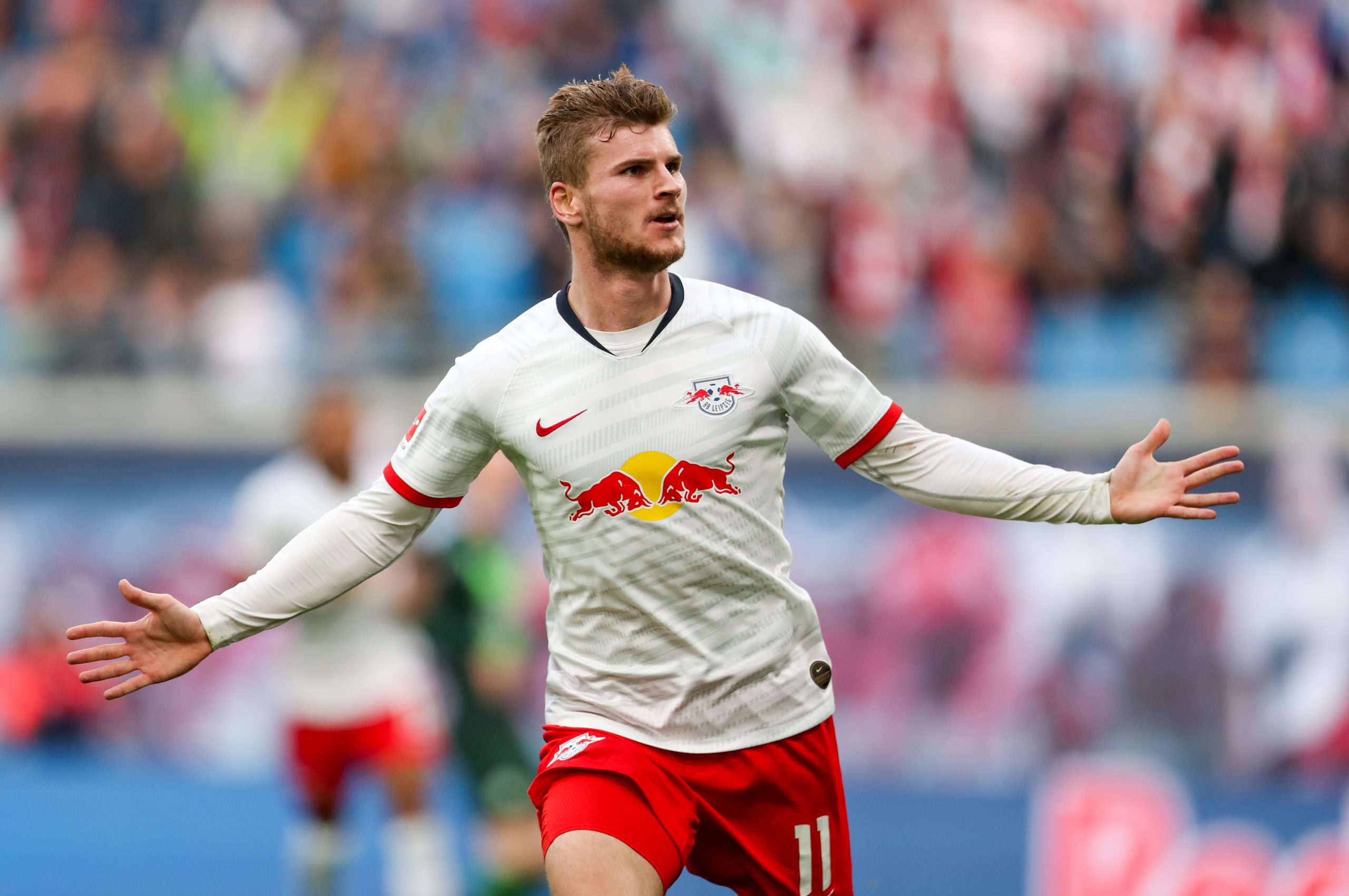Julian Nagelsmann still has big boots to fill. The thirty-two-year-old prodigy sealed the deal to make the move from TSG Hoffenheim to RB Leipzig before last season. When he arrived he had to follow an impressive season’s end led by Ralf Ragnick, the manager-come-sporting-direct-come-manager, for Leipzig in the 2018-19 season. Whilst the German coach has not come to reinvent Leipzig the wheel, he is in an environment which now suits him to the ground. His preferred free-flowing, intense, press-reliant approach fits like glove in hand when it comes to Leipzig. Up until their 3-1 home defeat to Schalke, Leipzig had only dropped two points all season – those coming at home to the reigning Champions, no less. And despite the fact that RB Leipzig have now gone four Bundesliga matches in a row without a win, their performances so far have been dazzling, showcasing not only an adaptation to each and every one of his opponents but also to the Leipzig team itself, when you compare its current approach to the one implemented by Nagelsmann at Hoffenheim. If they continue to perform like this, the points will come. So, without further ado, here is the first part of my detailed look at how the side from Saxony is adjusting to life under their new coach.
How they attack
Buildup play
So far this season, Nagelsmann has mostly set out his side in a back-three – though this has largely been opposition dependent. What has been more consistent, irrespective of back-fours or back-threes has been the double pivot, outside of the two games where they fielded 3-5-1-1 shapes – neither of those two performances were standouts, unsurprisingly. Just as important as how Leipzig attack higher up is that they ensure they can keep the ball when recycling it across the back, and they do so with certain trigger movements. When recycling it back from a wide area, the central centre-back will often step up into the number six position to move against the grain and create an alternative angle, which is also intending to drag deep the centre-forward but can instead open up the option to play inside if not.
It's not only about accessing the third man between the lines, who can then step onto the ball goal-facing, but also recycling the ball between the midfield and defence to evade pressure. This was especially well used in their 3-2 victory over Borussia Mönchengladbach.
The ways they build to the next phase of play
In Naglesmann's very first league game in charge (a 4-0 win away versus Union Berlin), there were already clear mechanisms in place to try and bypass the first lines of pressure. Most of these involved the far-sided holding midfielder being positioned diagonally ahead from his partner, establishing better angles for stronger connections from the centre backs, and facilitating quick positional rotations, as well as the manipulation of opposition’s midfield.
This kind of positional awareness and interchangeability, as seen above, is what is at the core of every Leipzig attack. And there are so many other ways in which Leipzig try to tackle the first phase, a lot of which I can’t even begin to fit into this analysis. One result is a relentless focus on the defenders moving the ball relentlessly into midfield via short high percentage passes. Here we see all the passes from centre backs in their own defensive third to midfielders. They're overwhelmingly short passes aimed at both keeping possession and setting the scene for moving the ball up the field 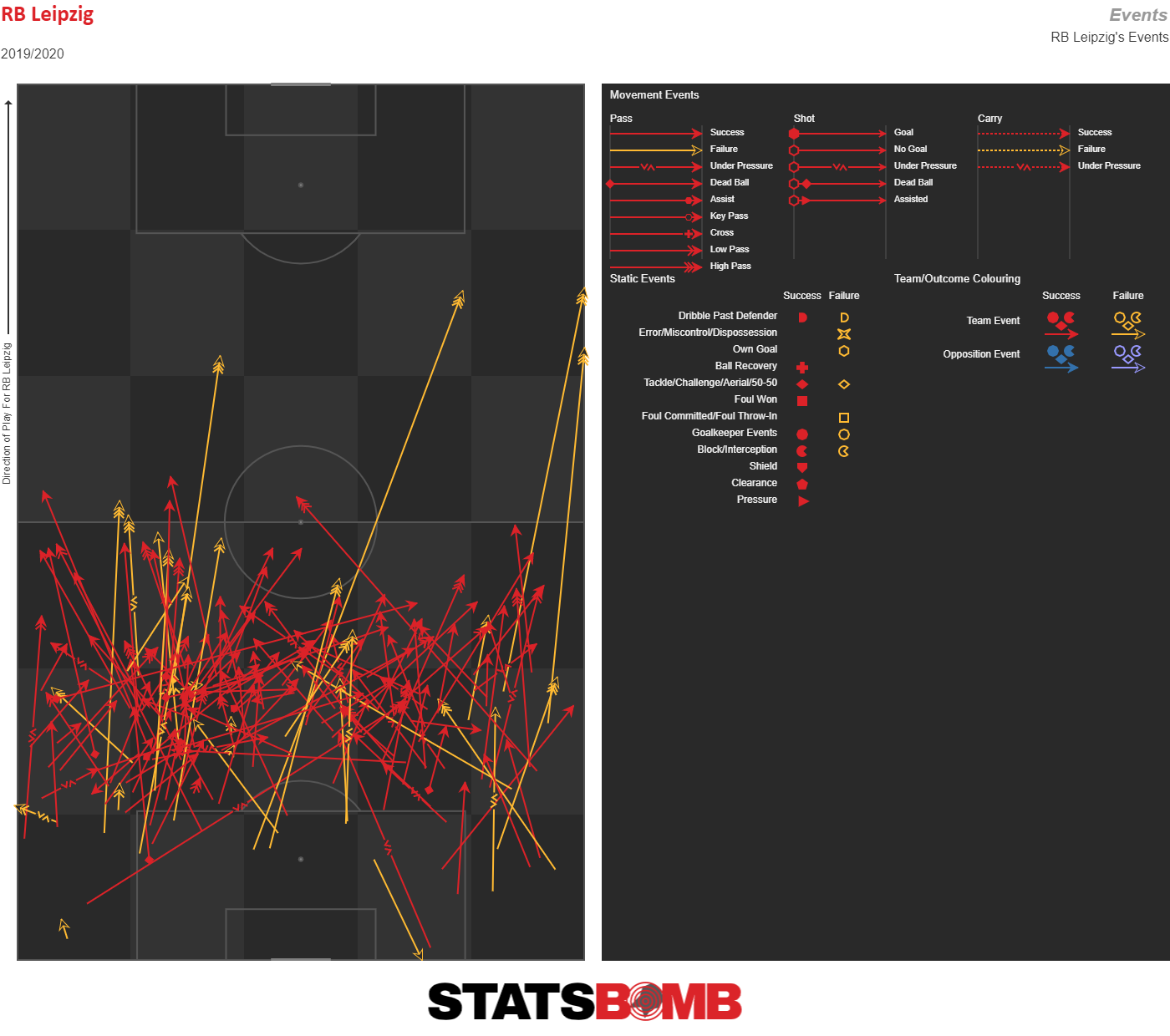 The side primarily uses the up-back-and-through strategy, which sees a forward player receive with their back to goal, only to lay it off to the goal-facing player deep of them, who will then launch it further forwards to a runner beyond the initial receiver. In their games against Union and Lyon, in particular, Leipzig attempted to do this by having the centre backs play it into Marcel Sabitzer’s feet, where the near-sided holding midfielder would – and in the case of the Union game, shift his position wider to be in line with the Austrian – receive goal-facing before they could then feed Lukas Klostermann’s runs beyond them.
The side primarily uses the up-back-and-through strategy, which sees a forward player receive with their back to goal, only to lay it off to the goal-facing player deep of them, who will then launch it further forwards to a runner beyond the initial receiver. In their games against Union and Lyon, in particular, Leipzig attempted to do this by having the centre backs play it into Marcel Sabitzer’s feet, where the near-sided holding midfielder would – and in the case of the Union game, shift his position wider to be in line with the Austrian – receive goal-facing before they could then feed Lukas Klostermann’s runs beyond them.
Creases to iron out
However, what needs to be worked on is the pass selection. Since Leipzig are so heavily ball-sided, there is a risk that comes with playing into the underloaded side. There have been times when a far-sided fullback/wing-back or an attacker receives a pass at a time when there is no support accessible to them. There have also been instances of playing into the isolated fullback/wing-back, which has led to easy dispossessions.
Given that (as well as attackers general inclination towards being a higher turnover position), it's unsurprising that Werner, Sabitzer and Yussuf Poulsen lead Leipzig in turning the ball over. 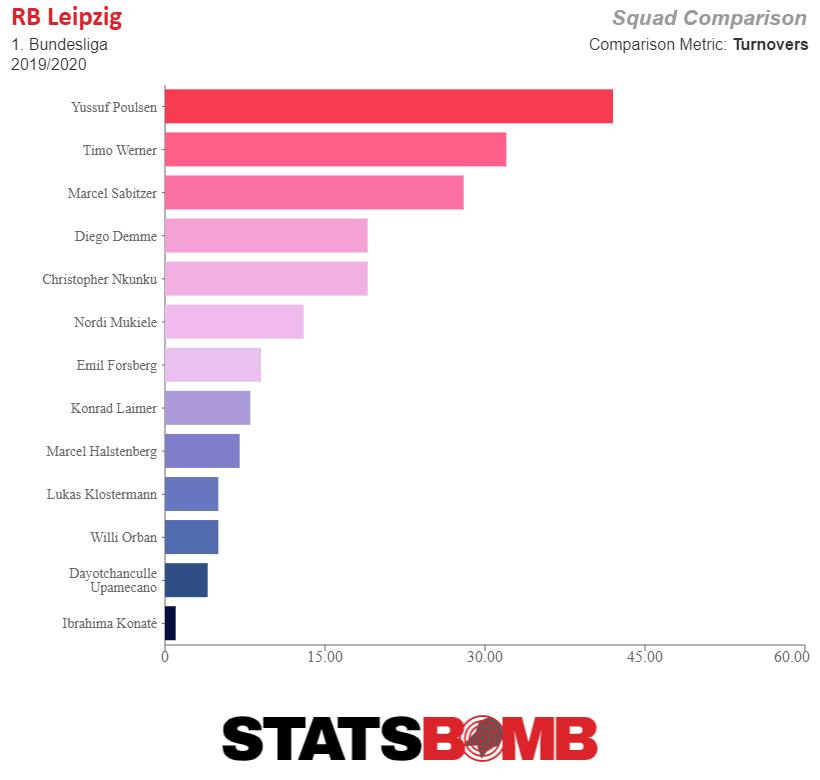 Where Leipzig have struggled altogether in buildup has been in the two aforementioned games, against Frankfurt and Werder Bremen, where they fielded 3-5-1-1 setups in attack. The offensive shape is often a consequence of how Nagelsmann wishes to defend against opponents, which is, particularly at this early stage, potentially limiting given how unfamiliar the attackers are playing in certain systems. In the former, the main tactic was to have the near-sided wide forward move out to the wing to receive free of pressure, but when they did, they had no option to play into next. Here, Sabitzer drops wide, free of any marker, but has no options once he receives the ball there.
Where Leipzig have struggled altogether in buildup has been in the two aforementioned games, against Frankfurt and Werder Bremen, where they fielded 3-5-1-1 setups in attack. The offensive shape is often a consequence of how Nagelsmann wishes to defend against opponents, which is, particularly at this early stage, potentially limiting given how unfamiliar the attackers are playing in certain systems. In the former, the main tactic was to have the near-sided wide forward move out to the wing to receive free of pressure, but when they did, they had no option to play into next. Here, Sabitzer drops wide, free of any marker, but has no options once he receives the ball there. 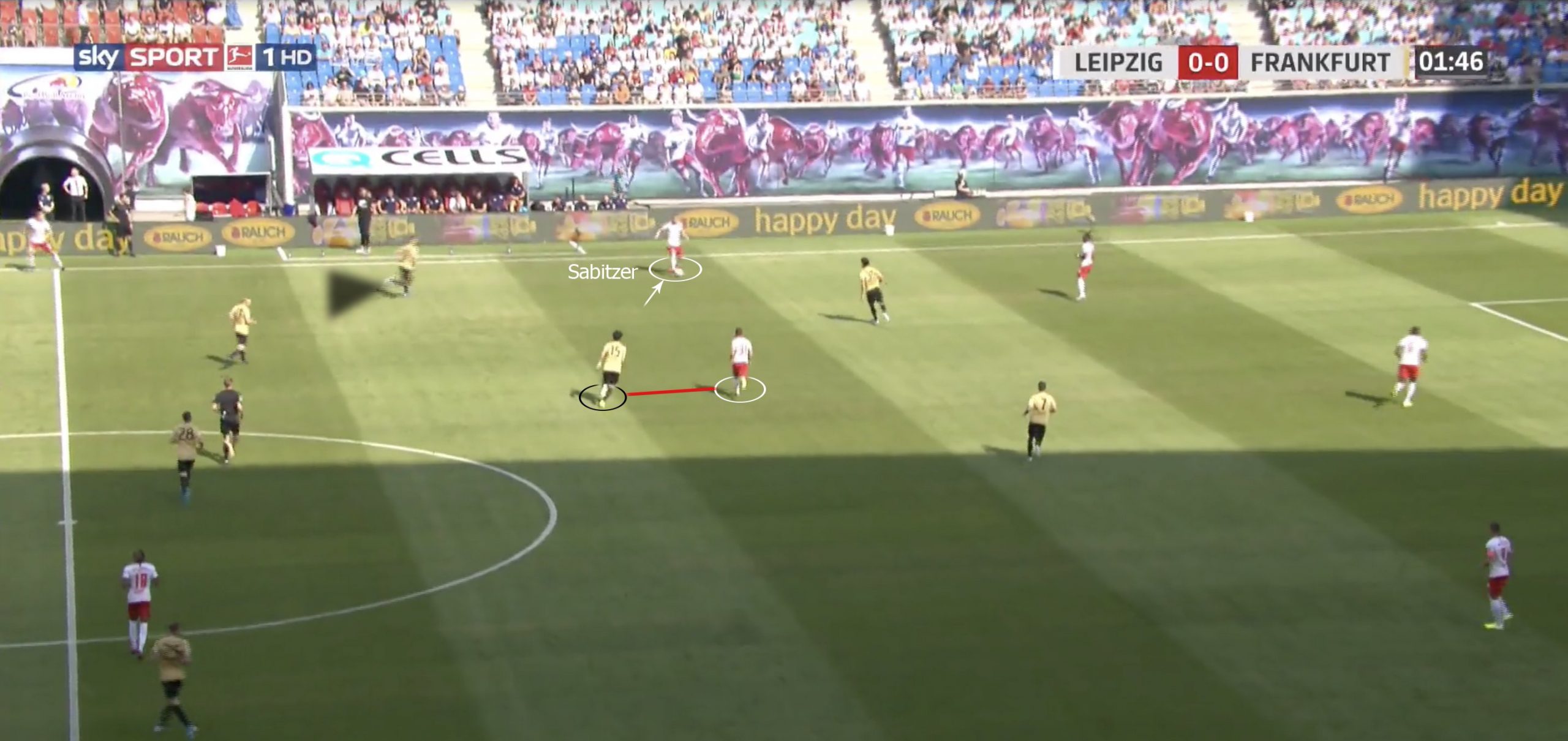
It’s the lacking combination plays and positional congestions which are the most telling factors. In comparison to their linkups in other matches, they were scarce, as was the amount of movement from attackers to stretch the space between the lines. What is vital to counteract this is that the fundamentals of possession exchanges improve, which they clearly have, despite the Werder match being a fairly recent one.
Strong combinative play in tight spaces
In reference to those lacking mechanisms, it has been their play between the lines in other games which have illustrated some of their most impressive stuff. Either with a front three or four, usually consisting of Poulsen, Werner, Sabitzer and/or Forsberg, the way they, and the double pivot, position themselves around the ball creates a sort of rondo which consistently manages to create space for teammates when there appears to be none.
As can be seen in the examples against Bayern and Schalke below, the staggering of the forwards means they always have the attackers triangulating around the ball, so within one attack, you’ll see a 2-1 shape shift to a 1-2 – and it could be around the flank, or it could be more towards the centre, in conjunction with the movements of other teammates to exploit or open up further space. There’ll always be one or two attackers making runs into depth, where another attacker will then drop against the grain into the opened-up space. What this does is create small networks that overload areas in and around the opposition’s defence, which pull open defensive channels and can be exploited by runs in behind.
Structuring to prepare for turnovers In line with this are the positions of the double pivot. The holding midfielders are asked to squeeze up very close to play. Their presence allows for an easy layoff for when the forwards receive with their back to goal but don’t know where to play it next. Equally, these positions enable them to, if not receive the ball, be first to pressure it, should the pass not come off.
Secondly, they can be an overloading presence in attack, especially in support of wide attackers, where the far-sided midfielder can often be seen pushing onto the edge of the box, from the blind-side, to link play into the middle undetected. The vertical split by the double pivot can also result in a stronger collective shape that cuts off access to the far-side upon turnovers.
Leipzig’s incredibly narrow shape also aims to contribute to this. The far-sided fullback/wing-back is often deep, narrow and tight to an opponent already to prevent the opportunity for long balls out of pressure. It, overall, makes for very impressive viewing. There are a couple of small things that have raised slight concerns – like, on a small number of occasions, players have stepped out whilst leaving their opponent accessible via wall passes – but it seems harsh to criticise something so frequently successful.
Second balls
To begin with, it didn’t seem all too prominent but from the Bayern game onwards – where they used it to great effect to escape the unrelenting pressure and turn the game around for themselves – it has come into play far more often, and for the better. Even in matches where Poulsen hasn’t been available, it’s been core to their play simply because of how they can setup around the ball. Here we can see al the successful high passes to Poulsen this season (crosses and throw-ins excluded). 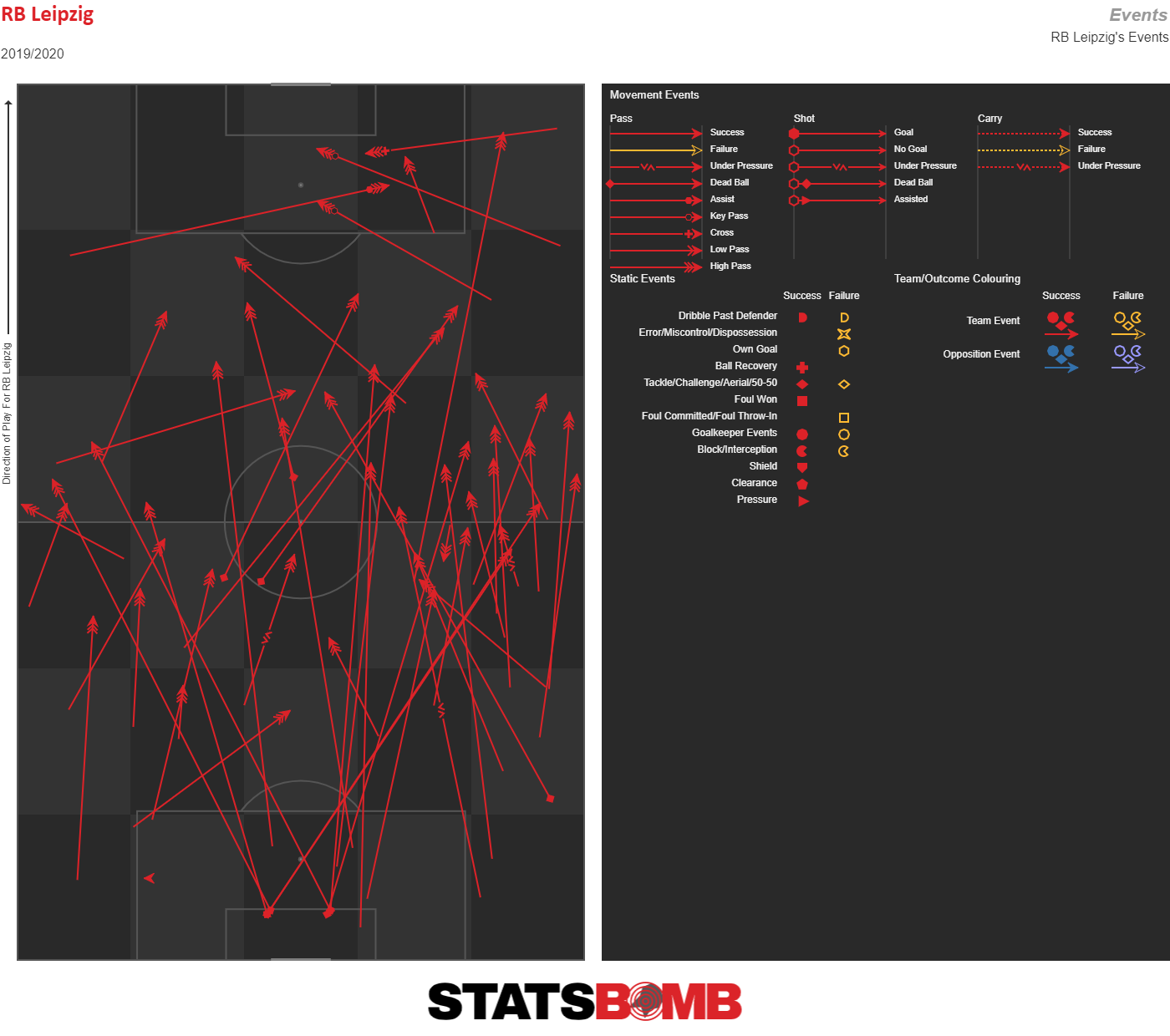 Typically, you’ll see Werner occupy positions either wide of or inside the near-sided fullback since these aerial balls are directed towards either halfspace, with his position pinning open space for Poulsen to challenge in. Deep of Werner are Sabitzer and/or Forsberg either side of the Dane, with the holding midfielder(s) pushed up to form a diamond around him, meaning that any balls coming back can be played forward into runners first-time.
Typically, you’ll see Werner occupy positions either wide of or inside the near-sided fullback since these aerial balls are directed towards either halfspace, with his position pinning open space for Poulsen to challenge in. Deep of Werner are Sabitzer and/or Forsberg either side of the Dane, with the holding midfielder(s) pushed up to form a diamond around him, meaning that any balls coming back can be played forward into runners first-time.
Counterattacks
When looking at the kinds of chances Leipzig create, it can be hard to pin a defined route, at least in settled possessions. They frequently look to get to the byline for cutbacks and drilled crosses to the back-post. Here are all the low crosses, and passes on the ground they've played into the box this season. 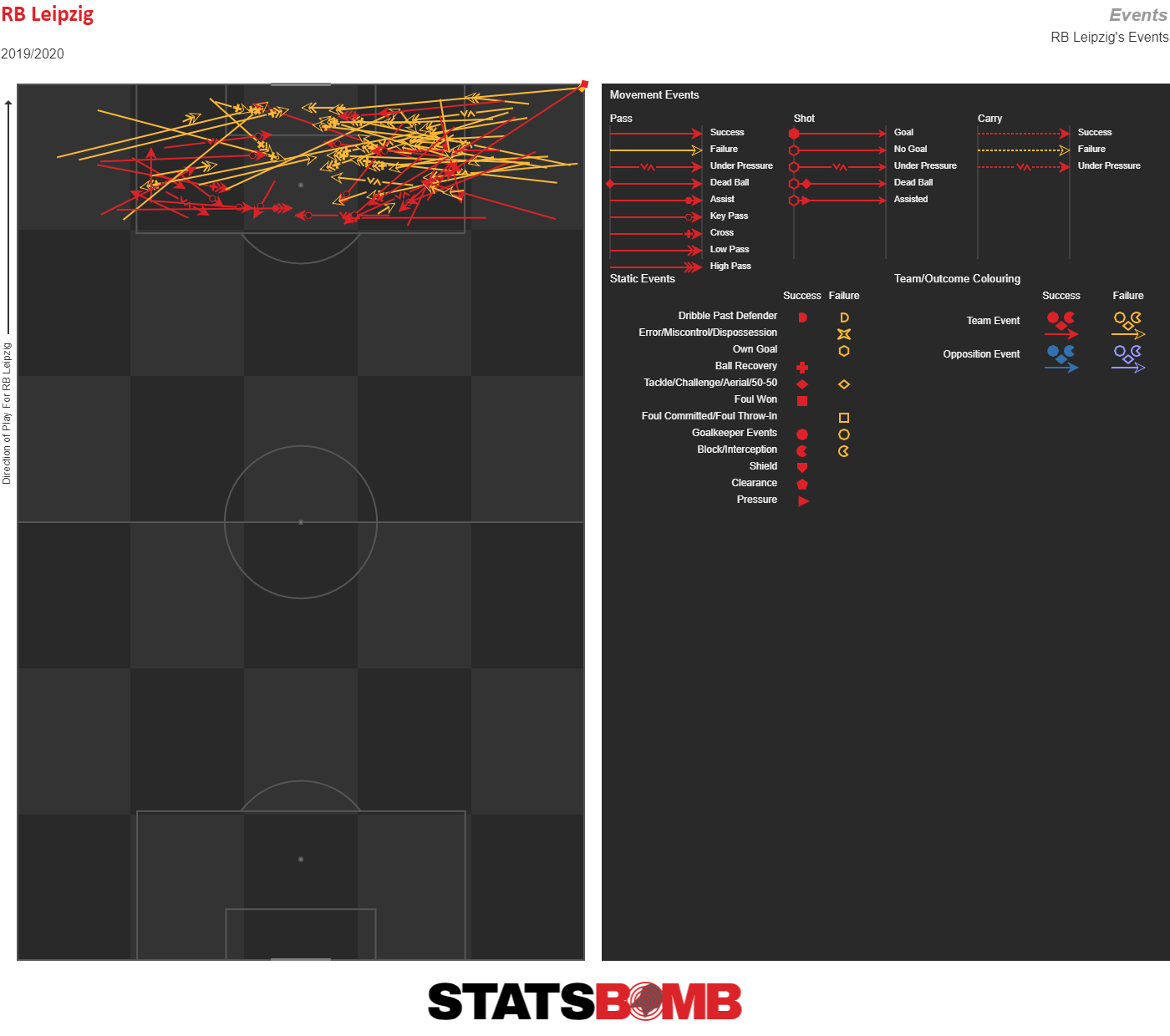 Clearly, though, their best chances, as you’d expect, come through quick transitions. The main way in which they’ve looked to escape pressure and set off attacks is based around the same up-back-and-through strategy they used in settled possession. This frequently involves Poulsen being readily available to receive the ball just ahead of the midfield line, where he can then lay it off to the various runners joining the attack, or simply back to the teammate who played it his way, as they will undoubtedly have more space to operate in after the exchange. Then, further ahead, you have Werner, particularly down the left side, moving as wide as possible to be both a short option and to be an attacker who can run from out-to-in.
Clearly, though, their best chances, as you’d expect, come through quick transitions. The main way in which they’ve looked to escape pressure and set off attacks is based around the same up-back-and-through strategy they used in settled possession. This frequently involves Poulsen being readily available to receive the ball just ahead of the midfield line, where he can then lay it off to the various runners joining the attack, or simply back to the teammate who played it his way, as they will undoubtedly have more space to operate in after the exchange. Then, further ahead, you have Werner, particularly down the left side, moving as wide as possible to be both a short option and to be an attacker who can run from out-to-in.
The priority is to create those spaces for goal-facing attackers. Against Leverkusen, they didn’t have Poulsen to bounce passes off, but they did still make use of square passes to play out of pressure and tee it up for goal-facing attackers to play it in behind.
That match contained a slightly different approach, as the ball was often instantly cleared up to Matheus Cunha and Werner, who looked to exploit the opposition’s very high line, and it worked to a tee, seeing them create a handful of big chances (all of which were squandered).
Conclusion
It’s hard not to get excited about the variety and fluency of these attacking mechanisms, that are as productive in sustaining pressure and creating chances as they are entertaining to watch. And, believe me, the features mentioned only scratch the surface of a team filled with so many other impressive tactical tidbits that help them breakdown opponents, even when they’re not at their resounding best. As alluded to, the only thing that has pegged them back in recent games has been their poor finishing. The extent of which can be seen through Timo Werner, who netted seven in Leipzig’s first five games, has cooled off remarkably, and missed a number of big chances, more or less balancing out the opening month of the season where he just couldn't miss. 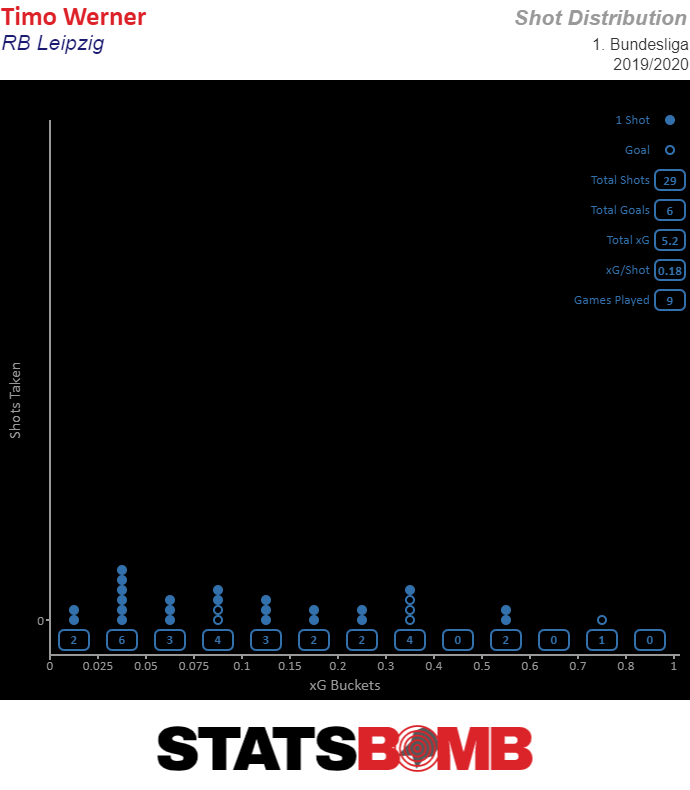 However, when you’re looking ahead and debating whether the current profiles can do enough to last the whole season, the one qualm might be the depth offered by Matheus Cunha, who pales in comparison to the balance Poulsen offer, but, statistically at least, you have four central attackers who are so experienced with this club and all have outstanding output so far, both in terms of creating and getting on the end of chances. When looking ahead, the sky really is the limit for this side, especially under the most talented young coach in the World, whose ceiling is yet to be established. ~ Stay tuned for part two, which will look at Leipzig’s pressing and defending.
However, when you’re looking ahead and debating whether the current profiles can do enough to last the whole season, the one qualm might be the depth offered by Matheus Cunha, who pales in comparison to the balance Poulsen offer, but, statistically at least, you have four central attackers who are so experienced with this club and all have outstanding output so far, both in terms of creating and getting on the end of chances. When looking ahead, the sky really is the limit for this side, especially under the most talented young coach in the World, whose ceiling is yet to be established. ~ Stay tuned for part two, which will look at Leipzig’s pressing and defending.
